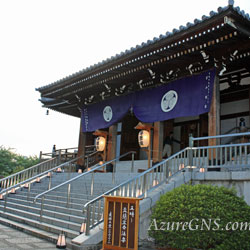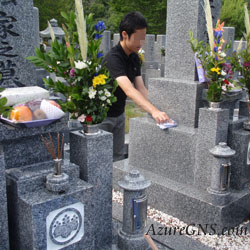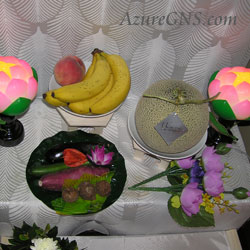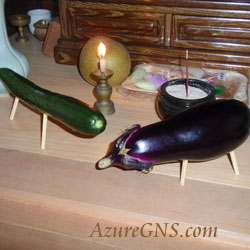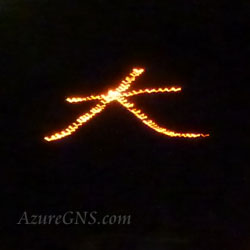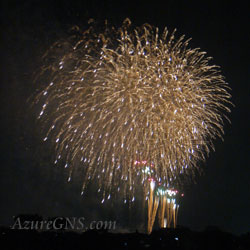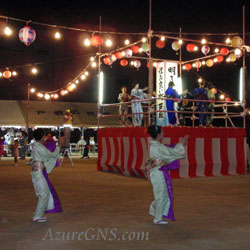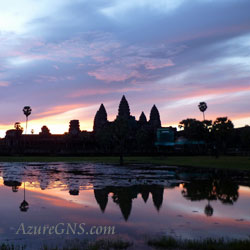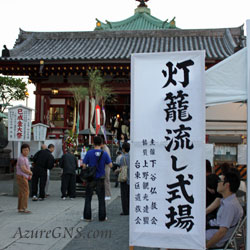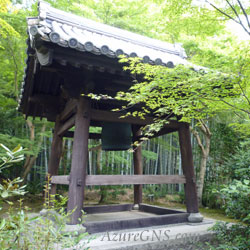(8月13日から16日まで)
O-bon;
The Bon Festival
(From August 13th to the 16th)
●お盆 O-bon; the Bon Festival; the Buddhist Souls Festival;
the Feast of Lanterns; the Buddhist Festival of the Dead
●仏教 Buddhism
●先祖;祖先 ancestors
●霊 soul
●迎え火 Mukae-bi; welcome fire
●送り火 Okuri-bi; send-off fire
●(京都の)大文字の送り火 huge Daimon-ji send-off fire (in Kyoto)
●寺 a temple
●お坊さん;僧侶 Buddhist priest
●墓 a grave; a tomb
●墓地 graveyard;(教会に属さない共同墓地)cemetery;
(教会付属)churchyard; (婉曲的に)memorial park
●仏壇 a butsudan; a home altar; a Buddhist’s altar kept in each household
●お供えもの offering
●供える (to) offer; (to) place as an offering
●胡瓜 a cucumber
●茄子 an eggplant
●盆踊り Bon-odori; Bon dance
●灯籠流し Toro-nagashi; a floating paper lantern
●お盆休み O-bon holiday
●帰省 (to) travel to one’s hometown
●交通 transportation
●大混雑する (to) be very congested
◆お盆は国民の祝日ではありませんが、日本で最も大切な年中行事の一つで、お正月と同じぐらい大切です。
O-bon is one of the most important annual events in Japan and is as important as O-shogatsu, the New Year’s celebration though it is not a national holiday.
◆お盆は8月の13日から16日までですが、7月13日から16日の地方もあります。
O-bon lasts from August 13th to the 16th, and in some districts, it is from July 13th to the 16th.
◆一般的には、お盆は亡くなった先祖の霊をこの世に迎え、短い間家族の元に帰って来てもらう仏教的な行事です。
Generally speaking, O-bon is a Buddhist rite to welcome the spirits of deceased ancestors back to this world for a brief reunion.
◆お盆にはお寺、神社、家庭、コミュニティーなどで多くの習慣と行事があります。
There are many customs and events for O-bon held at temples, shrines, homes, communities, and so on.
◆多くの人々は数日間の休暇をとり、故郷に帰ります。
Many people take several days’ holiday and return to their hometowns.
◆亡くなって初めて迎えるお盆は新盆(にいぼん、しんぼん)や初盆(はつぼん)と呼び、特に厚く供養します。
The first O-bon after one’s death is called Nii-bon, Shin-bon, or Hatsu-bon, and people hold a large-scale memorial service.
◆亡くなってからお盆まで四十九日を迎えていない場合は、翌年のお盆が新盆になります。
If 49 days have not passed since one’s death, one’s Nii-bon comes the following year.
◆人々はお墓に出かけて、墓石を掃除し、墓地の雑草を抜きます。
People visit the graves of their ancestors, clean the gravestones and weed the graveyards.
◆線香やろうそくに火をつけ、花、果物、野菜、お菓子などを墓前にお供えします。
People light incense and candles, and offer such things as flowers, fruits, vegetables and sweets in front of the graves.
◆先祖の冥福を祈るためにお参りします。
People pray in order to comfort the souls of those who have passed.
◆お盆を迎える前に、位牌や仏壇を掃除します。
In advance of O-bon, people clean their Butsudan (a family Buddhist altar) and ihai (a memorial tablet kept on the Butsudan).
◆仏壇の前に線香とろうそくを焚き、花、ごはん、果物、野菜などを供えます。
People light incense and candles, and offer flowers, rice, fruit and vegetables in front of the butsudan.
◆亡くなった人が好きだったお菓子やアルコール飲料をお供えすることもあります。
People also offer sweets and alcoholic drinks which the deceased liked when they were alive.
◆地方によって胡瓜と茄子に短く切った割り箸で4本の足を作り供えることもあります。
In some districts, they offer a cucumber and an eggplant with four legs which were made of shortened chopsticks.
◆胡瓜は馬を表し、先祖がこれに乗ってできるだけ急いであの世から家に戻れるように願いを込めて作ります。
A cucumber represents a horse, and one makes it praying that one’s ancestors come home on it from the next world as quickly as possible.
◆茄子は牛を表し、先祖がこれに乗ってできるだけゆっくり家からあの世に行くために作られます。
An eggplant represents a cow, and it is made so that one’s ancestor goes back to the next world as slowly as possible.
◆一般的に僧侶を家へ招いて、仏壇の前でお経をあげてもらいます。
A Buddhist priest is usually called to the home to recite the sutras in front of the Butsudan (a family Buddhist altar).
◆先祖の精霊を導くために家の前で迎え火を焚く地方もあります。
In some areas, people light Mukae-bi (welcome-fires) in front of their house to welcome the spirits of their ancestors.
◆先祖の精霊に別れを告げる時は送り火を焚きます。
They also light Okuri-bi (send-off-fires) to say farewell to the spirits.
◆京都の五山送り火(ござんのおくりび)が最も有名で規模の大きな送り火です。
Gozan-no-okuribi on Mt. Daimonji in Kyoto is the most famous and the largest scale of Okuri-bi.
◆5つの送り火が同夜に次々と点火され、京都の夏の夜に輝きます。
Five Okuri-bi are lit up one after another, and glow on a summer night in Kyoto.
◆お盆前後に全国で行われる花火大会は、今ではほとんどの人にとって楽しい夏のイベントですが、元々は送り火の一種です。
Fireworks displays held throughout Japan in and around O-bon season are originally a kind of Okuri-bi though they are now for most people exciting summer events.
◆花火大会は疫病や飢饉でなくなった多くの人の鎮魂のために、江戸時代(1603-1868)に始まりました。
Fireworks displays started in the Edo Period (1603-1868) for the consolation of the souls of those who passed away because of epidemics and famines.
◆お盆の最後の日に行われる、送り火の一種である灯篭流しも伝統行事です。
Toro-nagashi (Literally Toro means lantern and nagashi means flow) which is another style of Okuri-bi is also a traditional ceremony held on the last day of O-bon.
◆お盆の間帰ってきた精霊を送るために、紙の灯篭が川や海に流されます。
Small paper lanterns are floated on rivers and the sea, to say farewell to spirits which come back during O-bon.
◆近年は川や海の汚染が問題になり、灯籠流しは減少の傾向にあり、行われる場合も後に灯籠は回収されるようになりました。
These days, for fear of water pollution in the rivers and the sea, Toro-nagashi has been decreasing, or floating lanterns are collected.
◆青森県の青森ねぶた祭や弘前ねぶた祭は、元々灯籠流しの一種だと考えらえています。
The Aomori Nebuta festival and the Hirosaki Neputa festival in Aomori Prefecture are originally considered as kinds of Toro-nagashi.
◆日本各地で先祖の霊を慰めるため、盆踊りが行われます。
Bon-odori or Bon-dance is performed to comfort their ancestors’ souls all over Japan.
◆現在では盆踊りは宗教的行事というより、楽しむためにされているようです。
These days, Bon-odori is more of a fun event rather than a religious one.
◆伝統的な三大盆踊りは徳島県徳島市の阿波踊り、岐阜県郡上市(ぐじょうし)の郡上踊り、秋田県羽後町(うごまち)の西馬音内(にしもない)の盆踊であり、毎年多くの観光客が訪れます。
The three major traditional Bon-odori events are Awa-odori in Tokushima City, Tokushima Prefecture, Gujo-odori in Gujo City, Gifu Prefecture, and Nishimonai-no-Bon-odori in Ugo Town, Akita Prefecture, which attract many tourists every year.
◆お盆の時、電車、飛行機、高速道路はおそらく最も混雑するでしょう。
Trains, airplanes and freeways are perhaps at their most crowded during O-bon.
◆この期間に夏休みをとったり、海外旅行をしたりする人も多くいます。
Many people use this time for a summer vacation and travel abroad.
(より詳しい情報は「我が家のお盆」をご覧下さい。)
(Please see “Our Bon Festival Experience” for further information.)
Copyright (C) Azure Global Network Services. All Rights Reserved.

